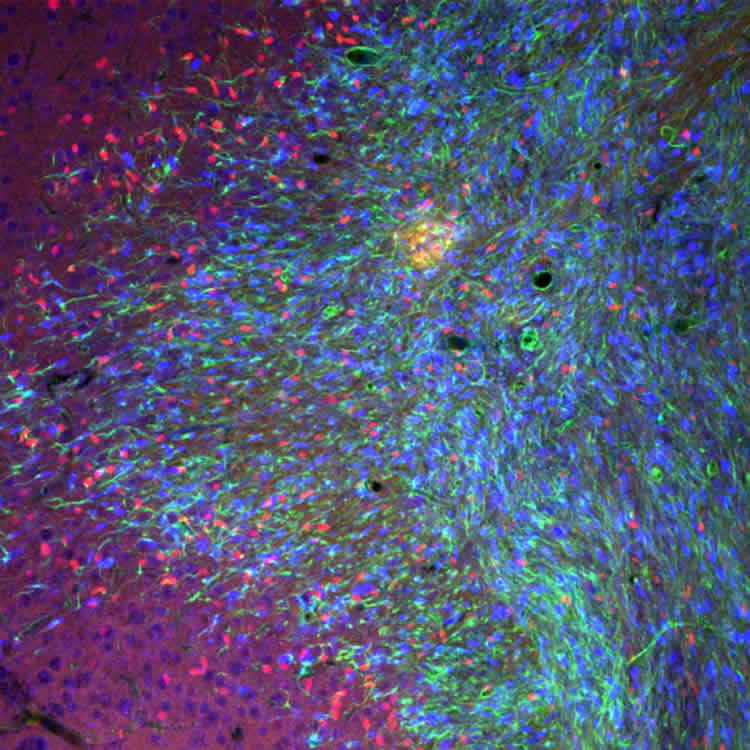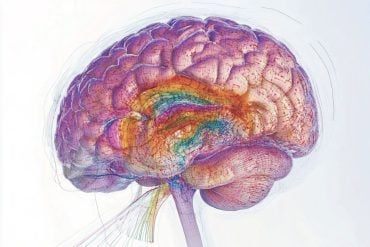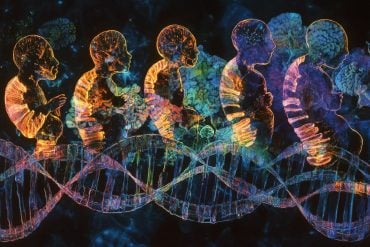Researchers report lab breakthrough in human cells, mouse models for high grade gliomas.
Researchers report in the journal Cancer Cell an experimental therapy that in laboratory tests on human cells and mouse models stops aggressive, treatment-resistant and deadly brain cancers called glioblastoma and high-grade gliomas.
A multi-institutional team led by researchers at Cincinnati Children’s Hospital Medical Center publishes their results on May 9.
Testing a multi-step therapeutic strategy, the scientists found a way to use a gene therapy to shut down a gene long-implicated in the formation of high-grade gliomas called Olig2. The protein encoded by Olig2 is expressed in the majority of gliomas. Removing the Olig2 gene halts tumor growth, while elimination of Olig2-producing cells blocks tumor formation.
“We find that elimination of dividing Olig2-expressing cells blocks initiation and progression of glioma in animal models and further show that Olig2 is the molecular arbiter of genetic adaptability that makes high-grade gliomas aggressive and treatment resistant,” said Qing Richard Lu, PhD, lead investigator and scientific director of the Brain Tumor Center at Cincinnati Children’s. “By finding a way to inhibit Olig2 in tumor forming cells, we were able to change the tumor cells’ makeup and sensitize them to targeted molecular treatment. This suggests a proof of principle for stratified therapy in distinct subtypes of malignant gliomas.”
The current study may apply to high-grade brain gliomas and a fatal brainstem tumor called DIPG (Diffused Intrinsic Pontine Glioma), which expresses Olig2 and is inoperable because of its location in a brain region controlling vital functions. Even if these cancers do initially respond to a specific targeted treatment, they adapt by finding genetic/molecular workarounds, evade treatment and continue growing.
Researchers caution the experimental therapeutic approach they describe requires extensive additional research and remains years away from possible clinical testing. Still, Dr. Lu said the data are a significant research breakthrough. The current study finds a potential chink in the molecular armor of these stubborn cancers that – even after an initial round of successful treatment – almost always relapse and kill the patients who get them.
The cancers form from precursors of supporting brain cells called oligodendrocytes, which help generate insulation for neural connections. Olig2 appears at the early stages of brain cell development. Through extensive analysis of human brain cancer cells and mouse models, the researchers observed Olig2 expression in early-stage dividing and replicating cells in tumors.
Olig2 contributes to the transformation of normal precursor cells into abnormal malignant cells that divide uncontrollably. In the context of cancer cell formation, the researchers saw Olig2 drive molecular processes that allow forming glioma cells to be highly adaptable and susceptible to the tumor-promoting effects of additional genetic changes.
Researchers then decided to eliminate Olig2-positive dividing cells during tumor formation. To use an approach more rapidly translatable from the laboratory bench to clinical bedside, they successfully tested a gene therapy that uses an engineered herpes simplex virus (viral vector) to deliver a suicide gene into replicating Olig2-positive cancer cells. They next administered an anti-herpes drug already in clinical use, ganciclovir (GCV). The Olig2-deleted tumors were not able to grow.
Researchers also found that after Olig2 was inhibited, the forming brain cancer cells switched directions and molecular composition- going from the cells resembling oligodendrocyte precursors to assume astrocyte-like brain cell characteristics. They continued to form tumors, however these newly formed astrocyte-like brain cancer cells produce the epidermal growth factor receptor (EGFR) gene at high levels.
EGFR is a common and effective target for chemotherapy drugs used clinically to treat tumors such as breast cancers. In repeated tests in mouse models, Olig2 inhibition prompted the glioma-forming cells to transform into EGFR-expressing astrocyte-like cells. Then, in subsequent and repeated testing on the transformed human and mouse model astrocyte-like cancer cells, the researchers treated the cells with an EGFR-targeted chemotherapy drug called gefitinib. The treatment stopped the growth of new tumor cells and tumor expansion.

Dr. Lu said that with additional testing, verification and refinement the experimental therapy could be especially helpful in preventing a recurrence of brain cancer in patients who have undergone an initial round of successful treatment. He added the new treatment approach would likely be used in combination with other existing therapies like radiation, surgery, other chemotherapies and targeted molecular treatments.
The scientists continue their research with additional testing in human cell lines and “humanized” mouse models of high-grade glioma. The mouse models are engineered to grow brain tumors derived from the tumor cells of specific patients whose families have donated biopsy samples for research. This allows researchers to test different targeted drugs in their therapeutic protocol that may best match the genetic makeup of tumors from specific individuals.
Funding: Funding support for the study came in part from the National Institutes of Health (R01NS078092, R01NS075243).
Source: Nick Miller – Cincinnati Children’s Hospital Medical Center
Image Source: The image is credited to Cincinnati Children’s.
Original Research: Abstract for “Olig2-Dependent Reciprocal Shift in PDGF and EGF Receptor Signaling Regulates Tumor Phenotype and Mitotic Growth in Malignant Glioma” by Fanghui Lu, Ying Chen, Chuntao Zhao, Haibo Wang, Danyang He, Lingli Xu, Jincheng Wang, Xuelian He, Yaqi Deng, Ellen E. Lu, Xue Liu, Ravinder Verma, Hong Bu, Rachid Drissi, Maryam Fouladi, Anat O. Stemmer-Rachamimov, Dennis Burns, Mei Xin, Joshua B. Rubin, El Mustapha Bahassi, Peter Canoll, Eric C. Holland, and Q. Richard Lu in Cancer Cell. Published online May 9 2016 doi:10.1016/j.ccell.2016.03.027
Abstract
Olig2-Dependent Reciprocal Shift in PDGF and EGF Receptor Signaling Regulates Tumor Phenotype and Mitotic Growth in Malignant Glioma
Highlights
•Elimination of mitotic Olig2+ cells inhibits glioma initiation and progression
•Olig2 loss reduces glioma growth and causes proneural-to-astrocytic phenotype shift
•Olig2 deletion causes PDGFR downregulation and reciprocal EGFR upregulation
•Inactivation of Olig2 potentiates sensitization of glioma cells to EGFR inhibition
Summary
Malignant gliomas exhibit extensive heterogeneity and poor prognosis. Here we identify mitotic Olig2-expressing cells as tumor-propagating cells in proneural gliomas, elimination of which blocks tumor initiation and progression. Intriguingly, deletion of Olig2 resulted in tumors that grow, albeit at a decelerated rate. Genome occupancy and expression profiling analyses reveal that Olig2 directly activates cell-proliferation machinery to promote tumorigenesis. Olig2 deletion causes a tumor phenotypic shift from an oligodendrocyte precursor-correlated proneural toward an astroglia-associated gene expression pattern, manifest in downregulation of platelet-derived growth factor receptor-α and reciprocal upregulation of epidermal growth factor receptor (EGFR). Olig2 deletion further sensitizes glioma cells to EGFR inhibitors and extends the lifespan of animals. Thus, Olig2-orchestrated receptor signaling drives mitotic growth and regulates glioma phenotypic plasticity. Targeting Olig2 may circumvent resistance to EGFR-targeted drugs.
“Olig2-Dependent Reciprocal Shift in PDGF and EGF Receptor Signaling Regulates Tumor Phenotype and Mitotic Growth in Malignant Glioma” by Fanghui Lu, Ying Chen, Chuntao Zhao, Haibo Wang, Danyang He, Lingli Xu, Jincheng Wang, Xuelian He, Yaqi Deng, Ellen E. Lu, Xue Liu, Ravinder Verma, Hong Bu, Rachid Drissi, Maryam Fouladi, Anat O. Stemmer-Rachamimov, Dennis Burns, Mei Xin, Joshua B. Rubin, El Mustapha Bahassi, Peter Canoll, Eric C. Holland, and Q. Richard Lu in Cancer Cell. Published online May 9 2016 doi:10.1016/j.ccell.2016.03.027






